紫式部

めぐり逢ひて
見しやそれとも
わかぬ間に
雲隠れにし
夜半の月かげ
むらさきしきぶ
めぐりあいて
みしやそれとも
わかぬまに
くもがくれにし
よわのつきかげ
Lady Murasaki Shikibu
We had met by chance -
She looked like that one-time friend,
If I saw clearly -
Then disappeared like
The face of the midnight moon.
Hokusai
Murasaki Shikibu (c. 973 - c. 1014 or 1025), was a novelist, poet, and a maid of honour of the imperial court during the Heian period. She is best known as the author of The Tale of Genji (English translation), written between about 1000 and 1008, one of the earliest novels in human history.
Some scholars have suggested that her given name might have been Takako (for Fujiwara Takako). Her diary states that she was nicknamed ‘Murasaki’ (purple wisteria) at court, after a character in The Tale of Genji. Shikibu refers to her father’s position in the Bureau of Ceremony (shikibu-sho). Contrary to customs of the time, her father gave her a male education; men were taught kanji and classical Chinese literature as the required culture, while women were taught kana and poetry. She also wrote the Murasaki Shikibu Diary (Japanese), and the Murasaki Shikibu Collection (128 poems), which were published posthumously. Daini no Sanmi (poem 58) was her daughter.
See also this wonderful site. In 2008 a commemoration of a thousand years of the Tale of Genji was held.
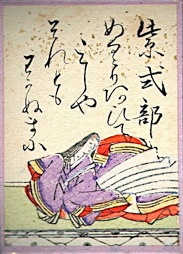

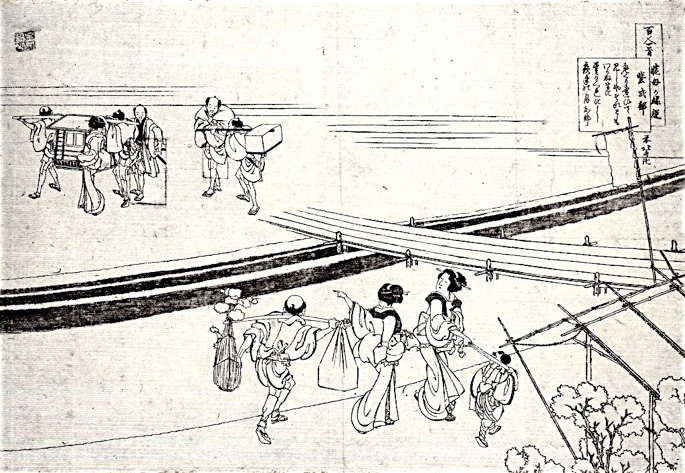
In some later versions, since the Edo-period, the last line reads: Yowa no tsuki ka na (moon at midnight), instead of Yowa no tsukikage (the moon’s light or silhouette).
There are different interpretations possible, depending on whether we take the headnote to this poem in her posthumously published collection to be written by herself or not. The note says that she had known someone as a child and briefly met that person who hurriedly left as if going after the moon. Many believe that person to have been a woman, whom the poet compares to the moon.
The connotations of so many words are so delicate and many-sided that it is practically impossible to give one pleasing translation.
Meguriaite means ‘meet by chance’, but could also mean ‘partners on a pilgrimage’. Sore to mo is ‘if it were, as if’, and sore tomo is ‘one-time friend’. Kakure nishi can mean ‘had hidden’ or ‘western refuge’ while nishi also means ‘the two’, and kumogakure means ‘disappearance’.
This complexity or ambiguity is the essence of the poem. It is maybe the most refined poem of this anthology.
On Hokusai’s drawing a woman is pointing towards another woman, as if she remembers her. There is a divide between them.
The tomb of Murasaki Shikibu is in Kyoto, next to that of Ono no Takamura (poem 11) (see placemark). She started writing The Tale of Genji at the Ishiyama-dera.
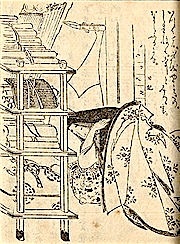
Murasaki Shikibu writing - by Yosai
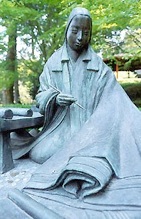
Her statue at the Ishiyamadera

Murasaki, purple, #884898
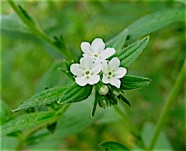
Murasaki plant, shikon
The murasaki colour is taken from the roots of the murasaki plant, also called shikon, the perennial plant Gromwell (Lithospermum erythrorhizon). Genji, in a poem, calls the murasaki or purple Gromwell, ‘the Lady of the Wisteria Court’, because its colour resembles the wisteria (in Japanese, fuji) thereby referring to Fujitsubo. During the Heian Period laws restricted murasaki-dyed clothing to the Empress and her ladies-in-waiting. Some translators render it as ‘lavender’, which is quite close.
